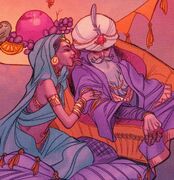Raghava Shah (talk | contribs) No edit summary |
No edit summary |
||
| (33 intermediate revisions by 15 users not shown) | |||
| Line 1: | Line 1: | ||
| − | {{Era| |
+ | {{Era|Individuals}} |
{{WP-REAL}} |
{{WP-REAL}} |
||
| + | {{Quote|You're one of a kind. Benevolent, they say. All castes and creeds under one roof. You haven't even the temper to order the death of one lowly thief.|Francis Cotton to Ranjit Singh, 1839.|Assassin's Creed: Brahman}} |
||
| − | {{Spoilerhd}} |
||
| + | {{Character Infobox |
||
| ⚫ | |||
| + | |image = ACBM-Ranjit Singh.jpg |
||
| + | |birth = 13 November 1780<br>{{Wiki|Gujranwala}}, {{Wiki|Sukerchakia Misl}} |
||
| + | |death = 27 June 1839 (aged 58)<br>[[Amritsar]], [[Sikh Empire]] |
||
| + | |species = [[Human]] |
||
| + | |database = [[Database: Ranjit Singh|Ranjit Singh]] |
||
| + | |affiliates = [[Sikh Empire]]}} |
||
| ⚫ | '''Maharaja Ranjit Singh''' (1780 – 1839) was the founder of the [[Sikh Empire]], which rose to power in the {{Wiki|Punjab}} region of the [[India]]n subcontinent in the early 19th century. He was also the safekeeper of the [[Koh-i-Noor]] diamond, a [[Isu|First Civilization]] artifact, from 1830 until his death. |
||
| + | ==Biography== |
||
| ⚫ | In 1830, Singh acquired the |
||
| + | ===Early life=== |
||
| + | Singh was the son of {{Wiki|Maha Singh}}, a small faction leader heading a ''misl'', one of many entities comprising the region at the time. During childhood, he contracted smallpox which resulted in the loss of one of his eyes. When he was twelve years old, Singh succeeded his father.<ref name="ACC">''[[Assassin's Creed Chronicles: India]]'' – [[Database: Ranjit Singh]]</ref> |
||
| + | ===Rise of the Sikh Empire=== |
||
| ⚫ | As the [[Assassins|Assassin]] [[Arbaaz Mir]] tried to prevent Singh from drinking more of his tea, Cotton instead placed the blame on the Assassin, making [[guards]] chase Mir through the palace. Singh's health quickly deteriorated, and his granddaughter [[Pyara Kaur]] came rushing to his aid. |
||
| + | {{Quote|Your people in Kashmir suffered a great tragedy, my friend. But those days have long passed and Singh's strength is all that stands between India and the growing British power.|[[Hamid (Amritsar)|Hamid]] to Arbaaz, 1839.|Assassin's Creed: Brahman}} |
||
| + | In the summer of 1799, Singh conquered the misl of {{Wiki|Lahore}}, the economic capital of the region. The ensuing expansion led him to be crowned Maharajah of Punjab at the age of twenty. Singh then launched an attack on the {{Wiki|Afghans}}, acquiring many territories where {{Wiki|Islam}} was the predominant religion.<ref name="ACC" /> |
||
| + | While some of its conquests were violent, the Sikh Empire was, on the whole, very progressive and open-minded for its time. For the Sikhs, the rigid Hindu system of social castes did not apply as they considered all men to be equal. Similarly, they allowed other religions to be practiced freely. Wanting to have his memory live on in the Sikh religion, Singh had the sacred temple of [[Harmandir Sahib]] adorned with marble and gold leaf. As a result, it was referred to as the "Golden Temple" by the western world.<ref name="ACC" /> |
||
| − | ==Reference== |
||
| + | |||
| + | With the annexation of [[Kashmir]] to the north and {{Wiki|Sindh}} to the south, {{Wiki|Muslims}} represented more than 70 percent of subjects in the Sikh Empire. It was a testament to its strength that the Empire remained standing while other Indian regions fell to the [[United Kingdom|British]]. Singh was adamant about remaining in control of his lands, his resolve strengthened by his knowledge of the [[Templars]] and their desires to obtain India and its riches.<ref name="ACC" /> |
||
| + | |||
| + | ===The Koh-i-Noor=== |
||
| + | {{Quote|Take the Syamantaka Mani and go. Far from here. They will come for you. All of you. Your uncles will not have the strength to hold the empire together. The Punjab may fall, but we may still protect India herself. Go. And never return.|Singh's last words to Pyara, 1839.|Assassin's Creed: Brahman}} |
||
| ⚫ | In 1830, Singh acquired the Koh-i-Noor diamond, a powerful [[Pieces of Eden|Piece of Eden]], serving as its keeper for nine years. He hid the real artifact in a secret chamber beneath his [[Ranjit Singh's summer palace|summer palace]] and wore a copy of it on his wrist. In 1839, the British Templars plotted to take the diamond from Singh by assassinating the Maharaja, realizing that his successors did not share Singh's determination to protect it. During a feast at the Maharaja's palace, Singh was poisoned by General [[Francis Cotton]].<ref name="Brahman">''[[Assassin's Creed: Brahman]]''</ref> |
||
| + | |||
| ⚫ | As the [[Assassins|Assassin]] [[Arbaaz Mir]] tried to prevent Singh from drinking more of his tea, Cotton instead placed the blame on the Assassin, making [[guards]] chase Mir through the palace. Singh's health quickly deteriorated, and his granddaughter [[Pyara Kaur]] came rushing to his aid. When she revealed that the Koh-i-Noor was in her possession, he implored her to flee the country with it and never return; Singh would perish that same night.<ref name="Brahman" /> |
||
| + | |||
| + | ==Legacy== |
||
| + | Even after his death, Singh was venerated by the Sikhs across the world as one of the greatest heroes in the culture. In 2003, a 22-meters bronze statue of Singh was installed in the {{Wiki|Parliament of India}}.<ref name="ACC" /> |
||
| + | |||
| + | ==Gallery== |
||
| + | <gallery captionalign="center" position="center" spacing="small" widths="180"> |
||
| + | ACBH Pyara with Ranjit Singh.jpg|Singh with his granddaughter |
||
| + | ACBH Pyara with dying Ranjit Singh.jpg|Singh's final moments |
||
| + | ACCI DB Ranjit Singh.jpg|Singh in the [[Helix]] database |
||
| + | </gallery> |
||
| + | |||
| + | ==Appearances== |
||
*''[[Assassin's Creed: Brahman]]'' |
*''[[Assassin's Creed: Brahman]]'' |
||
| + | *''[[Assassin's Creed Chronicles: India]]'' {{Mdat}} |
||
| + | |||
| + | ==References== |
||
| + | {{Reflist}} |
||
{{ACBM}} |
{{ACBM}} |
||
| − | {{DEFAULTSORT:Singh, Ranjit}} |
+ | {{DEFAULTSORT: Singh, Ranjit}} |
[[Category:1780 births]] |
[[Category:1780 births]] |
||
[[Category:1839 deaths]] |
[[Category:1839 deaths]] |
||
[[Category:Individuals]] |
[[Category:Individuals]] |
||
[[Category:Indians]] |
[[Category:Indians]] |
||
| + | [[Category:Punjabis]] |
||
| + | [[Category:Maharajas of the Sikh Empire|Ranjit]] |
||
[[Category:Individuals who held Pieces of Eden]] |
[[Category:Individuals who held Pieces of Eden]] |
||
[[Category:Ancestors of Monima Das]] |
[[Category:Ancestors of Monima Das]] |
||
| + | [[Category:Sukerchakia dynasty]] |
||
Revision as of 12:17, 2 March 2019
- "You're one of a kind. Benevolent, they say. All castes and creeds under one roof. You haven't even the temper to order the death of one lowly thief."
- ―Francis Cotton to Ranjit Singh, 1839.[src]
Maharaja Ranjit Singh (1780 – 1839) was the founder of the Sikh Empire, which rose to power in the Punjab region of the Indian subcontinent in the early 19th century. He was also the safekeeper of the Koh-i-Noor diamond, a First Civilization artifact, from 1830 until his death.
Biography
Early life
Singh was the son of Maha Singh, a small faction leader heading a misl, one of many entities comprising the region at the time. During childhood, he contracted smallpox which resulted in the loss of one of his eyes. When he was twelve years old, Singh succeeded his father.[1]
Rise of the Sikh Empire
In the summer of 1799, Singh conquered the misl of Lahore, the economic capital of the region. The ensuing expansion led him to be crowned Maharajah of Punjab at the age of twenty. Singh then launched an attack on the Afghans, acquiring many territories where Islam was the predominant religion.[1]
While some of its conquests were violent, the Sikh Empire was, on the whole, very progressive and open-minded for its time. For the Sikhs, the rigid Hindu system of social castes did not apply as they considered all men to be equal. Similarly, they allowed other religions to be practiced freely. Wanting to have his memory live on in the Sikh religion, Singh had the sacred temple of Harmandir Sahib adorned with marble and gold leaf. As a result, it was referred to as the "Golden Temple" by the western world.[1]
With the annexation of Kashmir to the north and Sindh to the south, Muslims represented more than 70 percent of subjects in the Sikh Empire. It was a testament to its strength that the Empire remained standing while other Indian regions fell to the British. Singh was adamant about remaining in control of his lands, his resolve strengthened by his knowledge of the Templars and their desires to obtain India and its riches.[1]
The Koh-i-Noor
- "Take the Syamantaka Mani and go. Far from here. They will come for you. All of you. Your uncles will not have the strength to hold the empire together. The Punjab may fall, but we may still protect India herself. Go. And never return."
- ―Singh's last words to Pyara, 1839.[src]
In 1830, Singh acquired the Koh-i-Noor diamond, a powerful Piece of Eden, serving as its keeper for nine years. He hid the real artifact in a secret chamber beneath his summer palace and wore a copy of it on his wrist. In 1839, the British Templars plotted to take the diamond from Singh by assassinating the Maharaja, realizing that his successors did not share Singh's determination to protect it. During a feast at the Maharaja's palace, Singh was poisoned by General Francis Cotton.[2]
As the Assassin Arbaaz Mir tried to prevent Singh from drinking more of his tea, Cotton instead placed the blame on the Assassin, making guards chase Mir through the palace. Singh's health quickly deteriorated, and his granddaughter Pyara Kaur came rushing to his aid. When she revealed that the Koh-i-Noor was in her possession, he implored her to flee the country with it and never return; Singh would perish that same night.[2]
Legacy
Even after his death, Singh was venerated by the Sikhs across the world as one of the greatest heroes in the culture. In 2003, a 22-meters bronze statue of Singh was installed in the Parliament of India.[1]
Gallery
Appearances
- Assassin's Creed: Brahman
- Assassin's Creed Chronicles: India (mentioned in Database entry only)
References
| |||||||||||||||||||||||||


